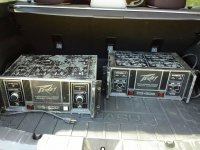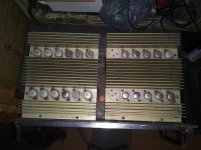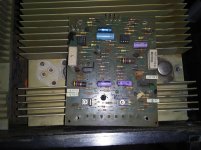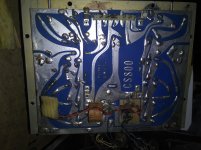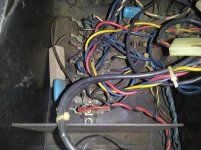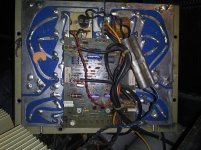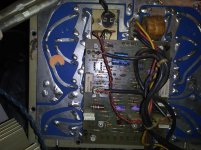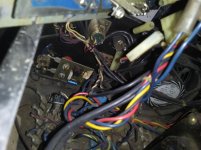A 4580 to replace the 4558 RC4580IP Texas Instruments | Mouser
A 5534 OP Amp SA5534AP Texas Instruments | Mouser
1N4148 diodes 1N4148 Fairchild Semiconductor | Mouser
MPS6534 (replaces MPS6533) (replaces transistor Q8) MPS6534_D75Z Fairchild Semiconductor | Mouser
MPS6531 (replaces MPS6530) (replaces transistor Q7) MPS6531_D75Z Fairchild Semiconductor | Mouser
2N5461 (Q1) 2N5461 Fairchild Semiconductor | Mouser
2N5401 (Replaces 2N5400) (Q2)2N5401G ON Semiconductor | Mouser
2N5086 (Replaces SPS690) (Q3) 2N5086 Central Semiconductor | Mouser
MPSA18 (Replaces TI923) (Q4) MPSA18RLRMG ON Semiconductor | Mouser
MPSW42 (Replaces MPSU10) (Q6)MPSW42RLRAG ON Semiconductor | Mouser
MPSW92 (Replaces MPSU60) (Q5) MPSW92RLRAG ON Semiconductor | Mouser
MJE340 (Q9) MJE340G ON Semiconductor | Mouser
MJE350 (Q10) MJE350G ON Semiconductor | Mouser
1N4744 (replaces the 40102 zener diodes) (CR6 and CR10) 1N4744A_T50R Fairchild Semiconductor | Mouser
Enzo, how does this list look? Are all these components correct, or a good substitute? I'm planning on placing a Mouser order with in 2 weeks. Also, is the pinouts for the transistors, and the transistor substitutes the same as the original? From my quick glance, the pinouts are correct.
A 5534 OP Amp SA5534AP Texas Instruments | Mouser
1N4148 diodes 1N4148 Fairchild Semiconductor | Mouser
MPS6534 (replaces MPS6533) (replaces transistor Q8) MPS6534_D75Z Fairchild Semiconductor | Mouser
MPS6531 (replaces MPS6530) (replaces transistor Q7) MPS6531_D75Z Fairchild Semiconductor | Mouser
2N5461 (Q1) 2N5461 Fairchild Semiconductor | Mouser
2N5401 (Replaces 2N5400) (Q2)2N5401G ON Semiconductor | Mouser
2N5086 (Replaces SPS690) (Q3) 2N5086 Central Semiconductor | Mouser
MPSA18 (Replaces TI923) (Q4) MPSA18RLRMG ON Semiconductor | Mouser
MPSW42 (Replaces MPSU10) (Q6)MPSW42RLRAG ON Semiconductor | Mouser
MPSW92 (Replaces MPSU60) (Q5) MPSW92RLRAG ON Semiconductor | Mouser
MJE340 (Q9) MJE340G ON Semiconductor | Mouser
MJE350 (Q10) MJE350G ON Semiconductor | Mouser
1N4744 (replaces the 40102 zener diodes) (CR6 and CR10) 1N4744A_T50R Fairchild Semiconductor | Mouser
Enzo, how does this list look? Are all these components correct, or a good substitute? I'm planning on placing a Mouser order with in 2 weeks. Also, is the pinouts for the transistors, and the transistor substitutes the same as the original? From my quick glance, the pinouts are correct.
Last edited:
Sorry to resurrect an old thread, but does anyone still have the full manual for one of these beasts? I contacted Peavey and all they had was the schematic, no board layout or parts lists.
Thanks in advance guys.
Thanks in advance guys.
Attachments
Last edited:
That looks like a couple of A revision.
The semiconductor PN is on the schematic and crosses as follows: TO92 can be 2n5401/2n5551 for the high voltage ones (80 up) and MPSA06/56 for lower voltages. TO126 7204 is MPSU10 and 7205 is MPSU60.
TO3 can be MJ15024.
The IC 5278 is a 741.
The triple diode in the heat sense stack can no longer be bought. You can buy them from Peavey parts department. Red led can be substituted electrically but it doesn't really fit in the slot in the heat sink for a DO41 package.
There was a complete semi cross list on Nymeria
Happy hunting.
The semiconductor PN is on the schematic and crosses as follows: TO92 can be 2n5401/2n5551 for the high voltage ones (80 up) and MPSA06/56 for lower voltages. TO126 7204 is MPSU10 and 7205 is MPSU60.
TO3 can be MJ15024.
The IC 5278 is a 741.
The triple diode in the heat sense stack can no longer be bought. You can buy them from Peavey parts department. Red led can be substituted electrically but it doesn't really fit in the slot in the heat sink for a DO41 package.
There was a complete semi cross list on Nymeria
Happy hunting.
Last edited:
Yeah I was hoping for the board layout, because I have some components missing.
For example, the first two transistors on the heatsink, as you look at it from above, the leftmost one in each row. Are they the drivers?
I need to get deeper into it once it comes out of quarantine.
I think I'm lucking out and they are Motorola's, because I have a 10 pack of MJ15024 (or something) which I had used a couple of on a Peavey Century, oddly enough, I'm hoping I can drop into the circuit to replace them. I'm going to have to re-read this thread on the transistor substitution thing.
For example, the first two transistors on the heatsink, as you look at it from above, the leftmost one in each row. Are they the drivers?
I need to get deeper into it once it comes out of quarantine.
I think I'm lucking out and they are Motorola's, because I have a 10 pack of MJ15024 (or something) which I had used a couple of on a Peavey Century, oddly enough, I'm hoping I can drop into the circuit to replace them. I'm going to have to re-read this thread on the transistor substitution thing.
Usually. I've only worked on Cs800s & PV-1.3k. If the emitters of the two to3 transistors go to the bases of all the other ones, they are drivers.Yeah I was hoping for the board layout, because I have some components missing.
For example, the first two transistors on the heatsink, as you look at it from above, the leftmost one in each row. Are they the drivers?
there is a little less cross conduction of the output transistors if the drivers are a little faster. Later models used MJ15020/21 as drivers, which had 20 mhz ft instead of 3 mhz.
These A models are a little hissy to tempt me, as a keyboard player. A is Great for beach bars & loud guitar or bass stage shows. where the volume is the same all the time. 741 is the source of the hiss. Later IC are not pin compatible with 741.
Last edited:
Ah OK, my bad, I thought someone had mentioned a component layout. Dang.
I thought several op-amps were pin-compatible with the 741, but it has been a long, long, time since I dabbled in op-amps.
These amps are not for putting the hi in my fi, but rather the bass in me place.
I thought several op-amps were pin-compatible with the 741, but it has been a long, long, time since I dabbled in op-amps.
These amps are not for putting the hi in my fi, but rather the bass in me place.
You would be surprised741 is the source of the hiss. Later IC are not pin compatible with 741.
And you think rightI thought several op-amps were pin-compatible with the 741
Um, the 5278 IC is a TL071, not a 741. On the C version they went to 5534.
You seem to have two different versions of amp, one looks to be an A series, but the other is a B or C. Look on the driver card on the output modules. The older A and B series have ONE IC on the card, the C version has two.
You seem to have two different versions of amp, one looks to be an A series, but the other is a B or C. Look on the driver card on the output modules. The older A and B series have ONE IC on the card, the C version has two.
I really hate it when people pooh-pooh Peavey CS-800s. They are ROCK SOLID, dependable performers that sound just fine. They have FAR outlasted Dynaco, Phase Linear, Crowns, SWTP, Audire, and Hafler amps in my experience. Yeah, they're HEAVY as hell but they're reliable.
I would like to ask Enzo, however---what mods do you recommend?
I would like to ask Enzo, however---what mods do you recommend?
I think I may have a mish-mash of parts, if such a thing is possible? Are the cards interchangeable?
These are pictures of the A series (the B series is working allegedley so I haven't cracked it open), both driver cards have two small 8 pin IC's. It appears that the ouput module was just dropped in backwards, and the pins for the driver module are bent, I'm assuming it goes the other way around, as that is how the screw holes on the edge will line up?
I'll also have to figure out how all the molex connectors connect. The hardware on this isn't metric is it? I'm guessing the little circuit board on the output is the triac board? Also, the TO-3's on the heatsink don't have an insulator washer do they? Just some heatsink compound?
These are pictures of the A series (the B series is working allegedley so I haven't cracked it open), both driver cards have two small 8 pin IC's. It appears that the ouput module was just dropped in backwards, and the pins for the driver module are bent, I'm assuming it goes the other way around, as that is how the screw holes on the edge will line up?
I'll also have to figure out how all the molex connectors connect. The hardware on this isn't metric is it? I'm guessing the little circuit board on the output is the triac board? Also, the TO-3's on the heatsink don't have an insulator washer do they? Just some heatsink compound?
Last edited:
I really hate it when people pooh-pooh Peavey CS-800s. They are ROCK SOLID, dependable performers that sound just fine. Yeah, they're HEAVY as hell but they're reliable.
They're not called the Bayou Behringer for nothing. I like 'em
I would like to ask Enzo, however---what mods do you recommend?
Further back in this thread, someone, don't recall who, recommends changing caps and op-amps I think on the driver board.
Last edited:
AND HERE ARE THE PICS.
Attachments
This thread dives off into CS800 with pictures on page 10. Pet Peeve Peavey (GPS 3500) - Page 10 - diyAudioI think I may have a mish-mash of parts, if such a thing is possible? Are the cards interchangeable?
These are pictures of the A series (the B series is working allegedley so I haven't cracked it open), both driver cards have two small 8 pin IC's. It appears that the ouput module was just dropped in backwards, and the pins for the driver module are bent, I'm assuming it goes the other way around, as that is how the screw holes on the edge will line up?
I'll also have to figure out how all the molex connectors connect. The hardware on this isn't metric is it? I'm guessing the little circuit board on the output is the triac board? Also, the TO-3's on the heatsink don't have an insulator washer do they? Just some heatsink compound?
There are other cs800 threads with pictures on solid state & PA forums, but as usual diyaudio search can't find them. CS800 is not really an instrument amp, doesn't have the right input sensitivity for guitar & bass instrument pickups.
Peavey tended in late 80's to use interboard ribbon cables named KKR , I bought pins for my PV-1.3k. None of the distributors index them that way, you have to have a 9 digit part # to look one up. Those driver boards are interchangeable driver to output board so you can put the bad one on top to repair it, but the interdriver board cable only fits one way. The jumper plug on the cs800a schematic is round, you would have to measure it to find one in a catalog.
The triac on rev A is to short the speaker, usually blown up in dead equipment. Disconnect for testing. The 8 v "sac 187" DC detector I bought from newark as a powerex bs08d, but you can use two 5 watt 8 v zeners line to line in parallel. Also known as a 2n4992. Ignore the middle pin on the powerex.
15 amp power switches are so expensive there may have been a running change at some point to turn the power on with a
triac on the case bottom with a resistor from 120 hot going through power switch to triac gate.
Last edited:
A thought on the interboard connectors. If they are .250", .187", or .085" wide, they are standard amp crimp terminals. They can be crimped with a stock klein or ideal crimp tool. All auto supplies have the .250" ones usually in the dorman line, and some have .187" and .085" ones. NAPA calls the .187" wide ones "ford ignition terminals" but they were used in appliances long before ford ever used them.
Great googly moogly! It's 2020 and people are still fixing CS800s....I'm not surprised one bit!
I noticed some people mentioning an old thread about changing parts on the drive board; that might be mine. Look in my thread about this amp for low hanging fruit mods and an easy to overlook cause of parasitic oscillation. CS 800 Repair (with pics!)
Power switches...If you have the TRIAC version, they should be perfectly reliable. If you have a Series I with no TRIAC, I expect your switch to be in pretty poor shape. You can replace it with something that will snap in there or use what's left to trigger a big relay or TRIAC. The switch needs to be rated for 15A minimum but 20A is preferred as the inrush current is NOT NICE on these amps.
There may be exceptions but from what I can tell, it's easy to determine the AC switching method without opening the unit.
No DDT and a white switch = no TRIAC
DDT and red switch = TRIAC
Of course, if you're feeling adventurous, you could just gut the thing and use the massive transformer, heat sinks and chassis for your own design. The transformer appears to have sufficient capacity for a 4 ohm bridge stable amp for short duty cycle applications like subwoofers.
I'm actually pretty happy with the sound after mods. I still think they're great choices for budget subwoofers or perhaps even small live sound operations where money is a serious concern and you're willing to get a serious workout for a nearly free amp. (Coronavirus has your gym closed? No problem, just carry around your CS800!)
Oh and if a mod can help me edit that old post, that would be awesome. I ditched photobucket for imgur years ago.
I noticed some people mentioning an old thread about changing parts on the drive board; that might be mine. Look in my thread about this amp for low hanging fruit mods and an easy to overlook cause of parasitic oscillation. CS 800 Repair (with pics!)
Power switches...If you have the TRIAC version, they should be perfectly reliable. If you have a Series I with no TRIAC, I expect your switch to be in pretty poor shape. You can replace it with something that will snap in there or use what's left to trigger a big relay or TRIAC. The switch needs to be rated for 15A minimum but 20A is preferred as the inrush current is NOT NICE on these amps.
There may be exceptions but from what I can tell, it's easy to determine the AC switching method without opening the unit.
No DDT and a white switch = no TRIAC
DDT and red switch = TRIAC
Of course, if you're feeling adventurous, you could just gut the thing and use the massive transformer, heat sinks and chassis for your own design. The transformer appears to have sufficient capacity for a 4 ohm bridge stable amp for short duty cycle applications like subwoofers.
I'm actually pretty happy with the sound after mods. I still think they're great choices for budget subwoofers or perhaps even small live sound operations where money is a serious concern and you're willing to get a serious workout for a nearly free amp. (Coronavirus has your gym closed? No problem, just carry around your CS800!)
Oh and if a mod can help me edit that old post, that would be awesome. I ditched photobucket for imgur years ago.
With two ICs on the driver cards, you have a C series. And in fact the schematic file for those does include a layout.
I don't have ANY mods I recommend, the things work fine as they came from the factory. I think any "improvements" like newer op amps will not make audible difference when these are used in live performance situations.
YES, the outputs MUST be insulated from the heat sink.
Crowbar triacs are on the speaker post boards.
Another ident idea. The A and B series have just two small transistors on the small board with the volume control. The C version has two ICs and other small parts on the volume control boards.
I don't have ANY mods I recommend, the things work fine as they came from the factory. I think any "improvements" like newer op amps will not make audible difference when these are used in live performance situations.
YES, the outputs MUST be insulated from the heat sink.
Crowbar triacs are on the speaker post boards.
Another ident idea. The A and B series have just two small transistors on the small board with the volume control. The C version has two ICs and other small parts on the volume control boards.
Attachments
Thanks for the schematic Enzo, the board layouts will be most helpful.
Is it possible to mix the modules? I have what appears to be (from what y'all have told me) a series A, it has the white HIGH TEMP indicator, the inputs are on the front, and the level knobs do not pull out. Yet that drive board you say is a Series C? I didn't pull the amp off the shelf as I had nowhere else to put it yet, so I couldn't see the control board itself.
Regards the TO-3's, I took one off the heatsink module, and they have an insulator underneath, but nothing round the screws, is that normal? Does the mica sheet provide insulation between the screws and the heatsink and it's going into a socket? In which case if I order these, I'm set?
Amazon.com: Yohii Mica Insulator Sheet for TO-3 Transistor 42mm/1.65" Length 29mm/1.14" Width - Pack of 200: Home Improvement
Thanks.
Is it possible to mix the modules? I have what appears to be (from what y'all have told me) a series A, it has the white HIGH TEMP indicator, the inputs are on the front, and the level knobs do not pull out. Yet that drive board you say is a Series C? I didn't pull the amp off the shelf as I had nowhere else to put it yet, so I couldn't see the control board itself.
Regards the TO-3's, I took one off the heatsink module, and they have an insulator underneath, but nothing round the screws, is that normal? Does the mica sheet provide insulation between the screws and the heatsink and it's going into a socket? In which case if I order these, I'm set?
Amazon.com: Yohii Mica Insulator Sheet for TO-3 Transistor 42mm/1.65" Length 29mm/1.14" Width - Pack of 200: Home Improvement
Thanks.
I still think they're great choices for budget subwoofers or perhaps even small live sound operations where money is a serious concern and you're willing to get a serious workout for a nearly free amp. (Coronavirus has your gym closed? No problem, just carry around your CS800!)
Now you've got me thinking, somewhere I had a spare barbell, and I have a frame only rack mount thing. Slice the rackmount, weld 4U of rail (double) onto each end of the barbell, hey presto.
And if you just want to tone up, I can buy a Class D, and bolt that on there instead.
And yes, these are for in-house / in-shed purposes mainly. In the modern parlance, man-cave merch.
- Home
- Live Sound
- Instruments and Amps
- Peavey CS-800 Issues.
